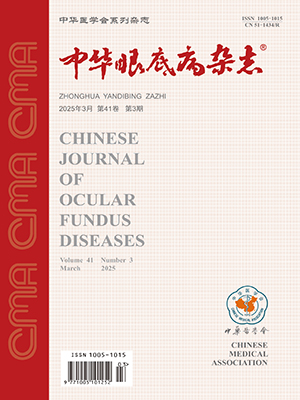Objective To compare the clinic therapeutic effect of intravitreal ranibizumab injection versus photodynamic therapy (PDT) combined with intravitreal ranibizumab injection for idiopathic choroidal neovascularizatio (ICNV), and to investigate the clinical effect and safety of treatment. Methods A randomized controlled clinical prospective study was performed for 27 patients (27 eyes) diagnosed as ICNV. Fourteen patients were assigned to receive PDT and intravitreal ranibizumab injection (combination roup.n=14); the control group was treated with only intravitreal ranibizumab injection (single group, n=13).The combination group was treated with an intravitreal injection of ranibizumab (0.5 mg/0.05 ml) 1 week after PDT. The bestcorrected visual acuity (BCVA) (logMAR), examination of the ocular fundus, fluorescence fundus angiography (FFA), indocyanine green angiography (ICGA) and optical coherence tomography (OCT) were performed respectively at 1, 2, 3, 6 and 12 months after treatment. If choroidal neovascularization (CNV) was only partially regressed or the leakage went on during follow-up, those patients were re-injected with ranibizumab. Results After 12 months, the average vision is 0.22 plusmn;0.11 in single group, and 0.21 plusmn;0.12 in combination group, and the differences were not significant (t=0.187, P=0.853). In single group FFA and ICGA showed completely closed CNV in 10 eyes (77.92%), and almost closed CNV in 3 eyes (23.08%) with obvious reduction of fluorescence leakage. In combination group FFA and ICGA showed completely closed CNV in 12 eyes (85.71%), and almost closed CNV in 2 eyes (14.29%) with obvious reduction of fluorescence leakage; OCT showed the subretinal fluid absorption and reduction of CNV. The average macular retinal thickness (MRT) in single groups is (167.96 plusmn;10.69) m, and in combination groups is (171.64 plusmn;11.30)m. In single and combination groups MRT decreased significantly at the final follow-up, but no significant differences in both groups (t=-0.887.P=0.389). The average number of intravitreal injection was (1.5 plusmn;0.7) in combination group and (2.4 plusmn;1.0) in single group (t=2.821,P=0.009). There were no ocular or systemic adverse events observed except for one patient with subconjunctival hemorrhage in the single group.Conclusions Intravitreal ranibizumab injection and PDT combined with intravitreal bevacizumab injection are both effective and safe for the patients with ICNV. The combined therapy can induce CNV regression, fundus hemorrhage and exudation absorption more effectively, and have less recurred CNV and side effects.
Citation: ,ZhongShan CHEN,Qin Ding,Yanping Song. Intravitreal ranibizumab injection combined with or without photodynamic therapy for idiopathic choroidal neovascularization: a comparative efficacy study. Chinese Journal of Ocular Fundus Diseases, 2013, 29(4): 362-366. doi: Copy
Copyright © the editorial department of Chinese Journal of Ocular Fundus Diseases of West China Medical Publisher. All rights reserved




